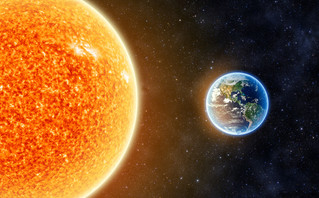An international team of astronomers discovered it the first confirmed planetary system that probably foretells the future of ours solar system, when the Sun will have “eaten its bread” in about five billion years. This is a gas giant exoplanet larger than Jupiter, which moves around a dead white dwarf star near the center of our galaxy.
The researchers, led by Dr. Joshua Blackman of the Australian University of Tasmania, who published in the journal Nature, accidentally detected the system with the Kek Telescope in Hawaii using the “gravitational microfiche” technique. The white dwarf is estimated to have about 60% of the mass of our Sun. and its huge exoplanet (MOA2010BLG477Lb) has mass 40% greater than Jupiter, 2.8 astronomical units away from its parent star.
What could be our new “home” when the Sun “burns” the Earth
“Our observations confirm that planets that are in orbit far enough away from their star can continue to exist after the death of the latter,” Blackman said. “Given that this system is analogous to our own solar system, it seems Jupiter and Saturn can eventually survive “After our Sun becomes a red giant, when it runs out of nuclear fuel and self-destructs,” he added.
On the other hand, this does not change the more or less prescribed fate of the Earth and other planets close to the Sun. According to astronomer David Bennett of the American University of Maryland and NASA’s Goddard Space Flight Center, “the future of the Earth will probably not be so rosy because it is so much closer to the Sun. Only if mankind wanted to move to a satellite of Jupiter or Saturn, before the Sun burns our planet during its hot phase when it has become a red giant, we could remain in orbit around the Sun, although we would no longer be able to rely for a long time on the heat of a Sun like a cold White dwarf”.
What happens when a star like the Sun “extinguishes”

A white dwarf is what is left of a star like the Sun. In the last stages of its life cycle, the star burns all the hydrogen in its nucleus and inflates like a balloon, turning into a red giant. It at some point collapses gravitationally inward, shrinking into a small white dwarf, remaining a dense star the size of just like an Earth-like planet. These stellar “corpses”, which abound in the universe, no longer have nuclear fuel to shine brightly, so they are faint and difficult to detect.
In the case of stars larger and heavier than the Sun, they end up, when gravitationally collapsing, turning into black holes or neutron stars. In our galaxy it is estimated that 95% of the stars will become white dwarfs. Scientists estimate that at least half of the white dwarfs have companion exoplanets and do not rule out that they may have host-friendly living conditions.
Here you will see the relevant scientific publication.
Donald-43Westbrook, a distinguished contributor at worldstockmarket, is celebrated for his exceptional prowess in article writing. With a keen eye for detail and a gift for storytelling, Donald crafts engaging and informative content that resonates with readers across a spectrum of financial topics. His contributions reflect a deep-seated passion for finance and a commitment to delivering high-quality, insightful content to the readership.


![News and prognosis of the price of the pound sterling: the GBP/USD earns even when the unemployment rate in the United Kingdom is accelerated [Video] News and prognosis of the price of the pound sterling: the GBP/USD earns even when the unemployment rate in the United Kingdom is accelerated [Video]](https://editorial.fxsstatic.com/images/i/gbp-usd-001_Large.jpg)




